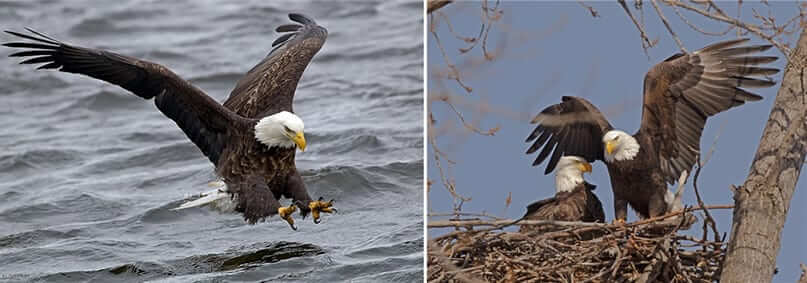Bald Eagles Are a Rich Part of Our Local Ohio History
In 1782, the bald eagle became the national emblem of the United States. It was a spiritual emblem for the Native American people much earlier. Benjamin Franklin was unhappy about the decision, claiming the bald eagle “is a Bird of bad moral Character. He does not get his Living honestly.”

Bald Eagle Nest at Pinery Narrows, Ohio (photo credit: www.the-news-leader.com/)
In 2006, bald eagles built a nest in the Pinery Narrows area; this was the first recorded nest in Cuyahoga County in over 70 years. Since that time, bald eagles flourished in the CVNP area. The wooded wetlands and fish population make Cuyahoga Valley a perfect habitat for eagles.
Visit, the CVNP website for a full nesting report.
What do Bald Eagles look like at birth vs. adulthood?
Bald eagles can live 28 years in the wild and 36 years in captivity. Young eagles have mostly brown wings and bodies with muddied white feathers. In five years, youngsters attain adult plumage: white heads, white tails, and chocolate brown bodies and wings.

(photo credit: akronzoo.org)
An adult bald eagle is 28-40 inches long with a wingspan of 80 inches. It is one of the largest birds in North America – it has a slightly wider wingspan than the great blue heron.
What do Bald Eagles Eat?
Bald eagles, as Benjamin Franklin said, are dishonest birds, preferring to steal someone else’s catch rather than work for their own. Observers often see eagles harassing other birds for their prey. When the bald eagles are not using devious means to steal others’ food, they scavenge through carrion or trash. Their main diet consists of fish but also includes mammals, gulls, and waterfowl.
What are the Nesting Habits of the Bald Eagle?
Bald eagles build large nests – 5-6 feet in diameter and 2-4 feet deep. Their nests may be flat or cylindrical. To build their nests, the birds weave together sticks, grass, moss, and cornstalks before lining the interior with lichen, vegetation, or feathers. Building a nest can take three months, but eagles reuse and expand these nests for years.
During late winter, bald eagles have 1-3 eggs. Because the eggs are sensitive to cold temperatures, adult eagles remain on the nest for constant incubation for 35 days. After about twenty days, the young eagles are ready to leave the nest.

Bald Eagle (photo credit: darkejournal.com)
Watch these majestic Bald Eagles in action at CVNP while you can!
Before settling as adults, young eagles spend four years nomadically exploring vast areas. Flying up to an altitude of 10,000 feet and 30-35 miles per hour, some eagles travel hundreds of miles each day, and sometimes a bird’s journey is tracked from Florida to Michigan, or California to Alaska.

Bald Eagle in flight (photo credit: ohioriders.net)
Despite their busy travel schedule, bald eagles make time for play; they use plastic bottles, sticks, or other objects as toys. Join us for one of our scheduled hikes to the Pinery Narrows and see these majestic birds in action!

